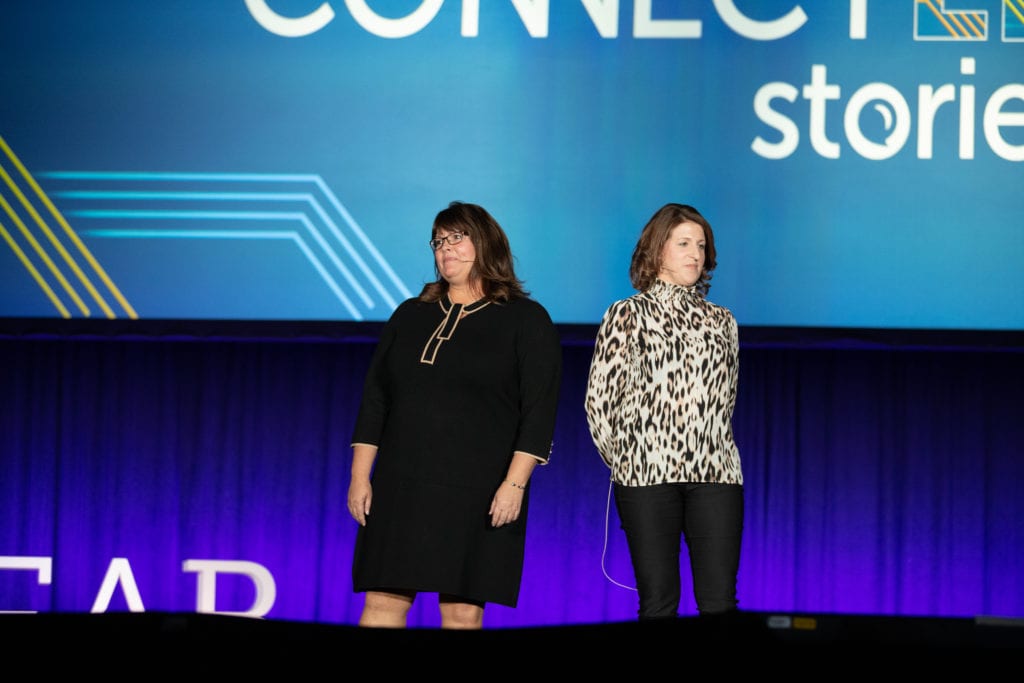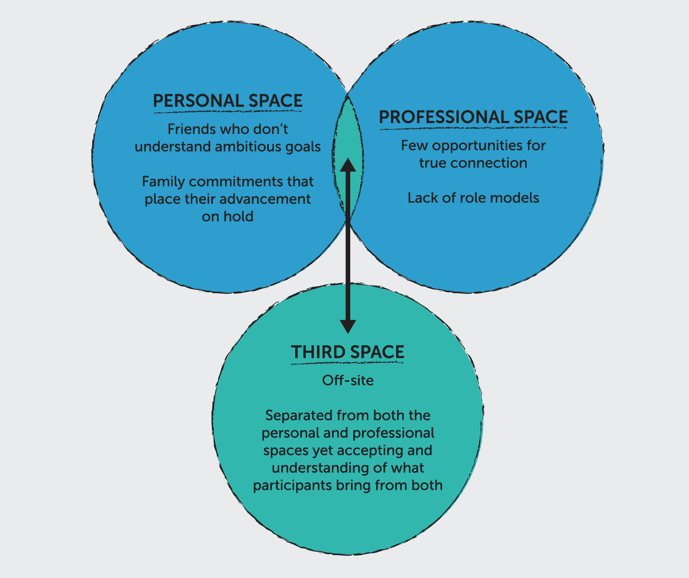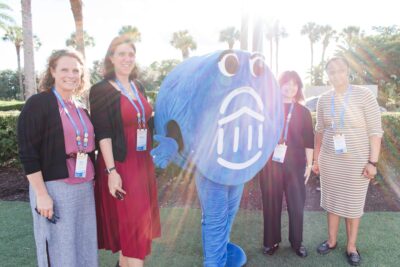How 2 administrators support each other’s success

Dr. Melissa Boog and Naomi Nash presenting their story during Connected 19.
In higher ed, we often talk about our students and how to help them be successful. When we talk about ourselves and our careers, we focus on professional development and degree attainment.
But who helps you be successful as you help others succeed?
Friendships between higher ed professionals are as powerful, if not more so, than any training you participate in or conference you attend. They can push you out of your comfort zone and help you become a stronger campus leader.
We’re speaking from experience because our own friendship with each other has been a source of inspiration, support, and guidance across the past 20+ years—even though we’re at very different institutions. Salisbury is a regional comprehensive university and Delaware is a big R1. We also lead very different personal lives. But it doesn’t matter. We don’t let institutional or personal differences get in the way of our powerful collaboration.
How they met
Dr. Boog: Naomi and I first met when I was the assistant director of admissions at Salisbury and Naomi was a student worker in the admissions office. After Naomi graduated, she started to work in admissions at other institutions.
Nash: Then, in 2006, I returned to Salisbury to work as an advisor. At the time, I was living in Annapolis and wasn’t sure how I was going to handle the two-hour commute to Salisbury every single day. So, I wrote to my Salisbury colleagues asking for short-term hotel recommendations.
I got some very nice responses, like “Best wishes” and “Can’t wait to see you back on campus.” But Melissa wrote, “Do you need a place to live? You can stay with me.” And I said “Well, yes I sort of do.” So we became roommates! Living together allowed us to grow even closer as friends as well as colleagues.
2 ways higher ed friendships can support your career goals
Build a support network to lean on
Dr. Boog: We’ve helped each other overcome professional setbacks. For example, when I opened the Advising Center at Salisbury, that first fall was the lowest point in my professional career. Faculty resented the advising center, and I became an easy target for them to point and say, “Look at administration making decisions without us.” I was really beat up that first semester.
So I leaned on Naomi and was vulnerable enough to reach out and say, “They’re really knocking me down here. Can you please remind me that I did a good thing?” When times get tough, you need someone in corner who can support you. Eventually, faculty came around to the Advising Center; now it’s a resource for them as well as students. But it was Naomi who encouraged me all along.
Find a trusted source of career advice
Nash: We’ve helped each other move our careers and our campuses forward. We all have supportive people in our lives, but not everyone is excited to geek out over platforms or curriculum. One weekend, Melissa and I were having some cocktails. You think we’re doing something more enlightening, but instead she’s talking about college software and this new initiative Salisbury is doing with EAB.
Flash forward to 2016—our then-vice president of enrollment management talks about signing a contract with EAB. My eyes lit up! “I have to get on this project!” The university created a student success position and I decided to apply for it. But I was up against two candidates with doctoral degrees, and I was doubting my own credentials. I felt like, “Why am I even putting myself forward for this job?”
Melissa helped me be as strong as I could be in that interview process. She helped me think through how to articulate my past work from the perspective of student retention, even though it wasn’t really called that at the time. And I got the job.
Why these support networks matter
Dr. Boog: When I thought about what makes my friendship with Naomi so meaningful, I was reminded of my dissertation. I’ve always been interested in how people support each other, particularly women. It can be difficult when you’re in leadership roles in higher ed. There are fewer women in top positions, and we can view each other as competition for promotions or resources.

As part of my research, I observed the HERs Institute, a two-week leader development experience for women in higher ed. I interviewed women who participated and asked why the experience was so unique to them.
I consistently heard participants talk about the parts of their personal and professional lives that were fraught with obstacles in regard to moving themselves forward. In both my interviews and the two weeks of observation, I saw a common theme: attendees benefited from finding a third space—a space away from their personal and professional lives, but one where they could bring those lives with them to help them grow in very special ways.
That’s what Naomi and I have been doing all along. And I think higher ed leaders need to tap into this space so they can get out of the weeds, get away from their own spaces, and connect on a different level.
Nash: When you’re just working with people on your campus, although they may be wonderful colleagues, a good idea can sometimes turn into a discussion about what will or won’t work. We’re less willing to talk best practice and big picture without immediately bringing up our own institutional roadblocks.
Watching what your peers do at other institutions can also help you understand that things take time and recognize the progress you’ve made. I knew it took Melissa three tries (and a few years) to make the case for more advisors, so I felt less discouraged when UD’s initial efforts to add advisors didn’t work either. I took lessons from Melissa on how to make a compelling case for advising resources and how to be persistent. And last year, from the hard work and dedication of many individuals at UD, we were able to hire nine new advisors.
How to connect with peers outside of your institution
Nash: You may think you don’t have the time to invest in a friendship. But once you make that connection, the time needed to maintain it is minimal. A quick phone call or an email can help you preserve that third space and build the relationship.
Dr. Boog: Sometimes it takes a bold move, like the one I made when I said to Naomi, “Hey don’t you dare pay for a hotel room. Come stay with me.” Of course, you don’t have to move in with your coworker or become lifelong friends to cultivate a strong, supportive relationship. But I promise you this—you will be better at helping your students succeed if you partner with someone else in your own success.
Editor’s note: Nash and Dr. Boog delivered this talk at EAB’s 2019 CONNECTED conference. Their speech has been lightly edited and adapted for the web by Kathleen Escarcha.
Watch Nash and Dr. Boog’s story below
More Blogs

Four signs it’s time to break up with your student CRM

Three lessons from 1,200 student success leaders on higher ed’s future
